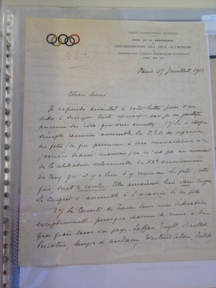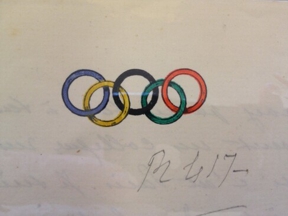 zachary harden
zachary harden
Keywords: olympic games | antwerp |
Links: FOTW homepage | search | disclaimer and copyright | write us | mirrors

Last modified: 2023-10-28 by  zachary harden
zachary harden
Keywords: olympic games | antwerp |
Links: FOTW homepage |
search |
disclaimer and copyright |
write us |
mirrors
See also:
Other sites:
Do we know yet if the Antwerp flag (the official one that went from
Antwerp 1920 to Seoul 1988 and was then replaced) has been found again?
It was reported missing a couple of years ago!
Herman de Wael, June 17, 2004
Not quite correct. The real story was that the original Antwerp 1920
flag went missing, so they had to make a replacement for the 1924 games.
That was in use until the 1988 games. By then it had become quite 'old
and frail', so another replacement was made for the 1992 games.
As for the missing 1920 flag, it was actually stolen as a souvenir (by
an American athlete, IIRC), who at long last returned it in person to
the IOC a few years ago (around the time of the Sydney 2000 games). The
ex-athlete wasn't punished, if only because he's too old to sit out any
time in jail ;-)
Miles Li, June 17, 2004
I am quite certain that the flag that was handed down until 1988 was
always referred to as the "Antwerp" flag, made in Antwerp from (I
don't remember what) Belgian cloth.
That is quite a different story. This is one of the many Olympic flags
that adorned the city in 1920, and it was indeed stolen, and returned,
and will now get a pride of honour place in our new museum. Strangely
it is the only remaining flag from hundreds that must have been made,
but it is not the official one.
The official one has (IIRC) never been seen again since 1988.
Herman de Wael, June 17, 2004
Hal Haig Prieste, an American athlete at the 1920 Olympic Games, climbed a 15 foot pole and stole the flag that was flying in the stadium. He didn't reveal that he had the flag until 1997. He was flown to the Sydney 2000 Olympic Games as a guest of the US Olympic Committee and in a very brief ceremony, at 103 years old, he personally returned the flag to IOC President Joan Antoni Samaranch i Torelló (Juan Antonio Samaranch). Prieste died the next year at 104 years of age (2001).
See his obituary at these websites (among many others):
Harvey Abrams, August 26, 2005
"At the end of the (1920) Games, the flag could not be found and a new
Olympic flag had to be made for the 1924 Summer Olympics in Paris. The
1924 flag then continued to be used at the Summer Olympics until the
Games of Seoul 1988 when it was retired. In 1997, at a banquet hosted
by the US Olympic Committee, a reporter
was interviewing Hal Haig Prieste who had won a bronze medal in
platform diving as a member of the 1920 US Olympic team.
The reporter mentioned that the IOC had not been able to find out what
had happened to the original Olympic flag. “I can help you with that,”
Prieste said, “It’s in my suitcase.” At the end of the Antwerp
Olympics, spurred on by teammate Duke Kahanamoku, he climbed a
flagpole and stole the Olympic flag. For 77 years the flag was stored
away in the bottom of his suitcase.
The flag was returned to the IOC by Prieste, by then 103 years old, in
a special ceremony held at the 2000 Games in Sydney. The original
Antwerp Flag is now on display at the Olympic Museum in Lausanne, Switzerland, with
a plaque thanking him for donating it."
Esteban Rivera, 22 January 2021
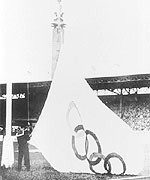
image located by Jan Mertens, 18 September 2011
A question thrown up on this page, concerning the possible disappearance of the
original 1920 Olympic ceremonial flag (the "Antwerp flag") is really resolved
here. This image does not show this flag
but a larger one used for the opening ceremony in the process of being raised -
see this page, about ¾ down right after the city map:
http://home.scarlet.be/~fhermans/antwerpen1920/opening.html
We learn that the first Olympic flag (the ceremonial one, or the one hoisted?)
was carried into the stadium by American swimmers (divers) Alice Lord and Aileen
Riggin.
(The coloured photo immediately following is interesting but not quite
trustworthy, witness the wrongly interpreted Antwerp municipal flag on the gate.)
Jan Mertens, 18 September 2011
Even allowing for the vagaries of black and white film, it's interesting to note
that the rings almost certainly weren't in what is now regarded as the standard
colour sequence. Blue does appear very light on black and white film, but it
looks very much like the first ring is the yellow one.
James Dignan, 19 September 2011
Well, sort of. It's not all that likely that one of the street flags missing
would have created a myth that the official flag had disappeared by the end of
the games. So, it would appear we're actually faced with two separate stories:
1 Prieste climbing a street pole to take a flag (I may have quoted a
contemporary news article, mostly a police report, on that one).
2 The city of Antwerp presenting the IOC with a flag, which then disappears
after which the IOC has a new flag made, though they still call it "The Antwerp
Flag".
2a The original official flag being brought in by the IOC, and the City of
Antwerp donating a new flag after that first one has gone missing.
According to Karl Lennartz - The
Story of the Rings, the Olympic flag was indeed stolen. This was the large
flag hoisted in the stadium, and the thieves were caught. He doesn't mention
whether that stadium flag was recovered, but had the thief been an Olympic
athlete, that certainly would have made the news as well.
He does give the size of Prieste's flag, 135,5 by 94 centimetres, so that's
obviously not the larger stadium flag. It's equally obvious not the Antwerp flag,
the ceremonial flag, as that was fringed, as can be seen when it's captured in
images of the medal ceremonies.
So, Prieste stole one of the street flags, several of which were indeed reported
stolen. The stadium flag was stolen as well, but Lennartz quotes Journal of
Olympic History 11 (2001) 1, p. 40 where the lowering of a flag from the large
pole is described. The Antwerp flag was present at at least one medal ceremony,
and Lennartz quotes from the same source its presence at the closing ceremony.
So, it's unlikely that the Antwerp flag was stolen, which for a staff flag is
less likely anyway, and the City of Antwerp probably donated the original flag,
as there was no need for a replacement.
I'm not sure why this story is on the proposals page, BTW.
Well, the Antwerp flag was replaced by the Seoul flags, and we quote the
description.
The Seoul flag is 2x3m; a flag of that size could well be carried into the
stadium by two persons.
The stadium flag nowadays is something like 3x6 m, and is carried by 8 persons.
(I keep telling myself I ought to check all recorded opening ceremonies, to
compare the flag details. Is the stadium flag the same size each Olympiad, or is
it growing?) That matches the photograph, but even rolled up it would be a hefty
burden for 2 people.
There are several national flag designs visible in front of the athletes.
Does anyone have an opinion on whether they are coloured correctly?
The next supposed theft of the Antwerp Flag was in St. Moritz in 1948. Not just
the flag itself was stolen, but its replacement as well. While the story of that
theft is probably verifiable, it's rather unlikely that this really was the
Antwerp Flag. For one thing, it's unlikely that a staff flag would have been
that accessible twice in a row; that's more likely for a stadium flag that is
flown from Opening Ceremony until Closing Ceremony. And for another, a
replacement would not easily have been available. But more importantly, until
the Oslo Games, 4 years later, the ceremonies of the Winter Games didn't
normally include a ceremonial flag. If an important flag was stolen in St.
Moritz, it's likely to have been the stadium flag. Anyone have anything specific
on that one?
The Antwerp flag that was replaced in 1988 by the Seoul Flags was donated to the
Olympic Museum in Lausanne and was put on display there. (And if it hasn't been
stolen, then it should be there still.)
Peter Hans van den Muijzenberg, 19 September 2011
Excellent source, yes. There we have the (almost) complete story. The gate was
only temporary, nowadays the stadum hosts Germinal Beerschot, a football team -
the laurels are gone.
Norway and Japan are allright, but others are not (a balck and white photo
places Italy to the left of Japan, so Italy was not in the left of the coloured
photo - all countries apparently ranged from right to left in French
alphabetical order). For a list of participating countries, see end of this
page.
See the quote at the end of p. 41 of Lennartz' article: the material of the flag
passed on to future organizers - the actual "Antwerp flag" was made of silk, and
embroidered.
Jan Mertens, 19 September 2011
It's not so much the presence of the gate I have a problem with as its absence.
This photograph you posted looks different, and do we see a tower in the
background?
Don't bother, it occurred to me that this is likely to be L.A. 1984: The Antwerp
Flag did travel from Moscow to Los Angeles, somehow, but nobody from the USSR
was in L.A. for a flag exhange ceremony. I can't recall the details, but this is
how the Official Report Los Angeles 1984 Vol 1 Part 1 page 210 describes it:
"The Olympic Charter-mandated portion of the ceremonies ... was begun with the
Antwerp Flag Exchange. IOC President Juan Antonio Samaranch presented the flag
to Los Angeles Mayor Tom Bradley who in turn presented the flag to LAOOC
Chairman Paul Ziffren. Two members of the United States Olympic delegation to
the 1920 Games in Antwerp, Alice Lord Landon and Aileen Riggen Seoule, were
included in the exchange ceremony."
If anyone has a video recording covering this we might get the exact details,
but I have little doubt that this is the association of the two ladies with the
Antwerp Flag.
BTW, the Los Angeles 1984 Olympics were the first time the exchange of the
Antwerp Flag was part of the Closing Ceremony. For the actual Antwerp Flag it
was also the last time, as since 1988 one of the Seoul Flags has been used in
its stead.
Peter Hans van den Muijzenberg, 20 September 2011
The Olympic Official Report Moscow 1980 Vol 2 Part 1, page 289 has a very clear
picture of the Antwerp Flag being transferred. In this picture, one can see how
the flag is connected to the staff: The Antwerp Flag is fastened to its staff by
six ribbons, from top to bottom: White, Blue, Yellow, Black, Green, and Red,
which is the same order as that of the colours on the flag.
This
photograph of the mayor of London waving the Seoul flag in Peking, shows
ribbons in the same order for that flag.
Peter Hans van den Muijzenberg, 20 September 2011
Concerning the stolen and returned flag, see colour photo on this
page.
Hoist held at right I see; rings touching.
Jan Mertens, 20 September 2011
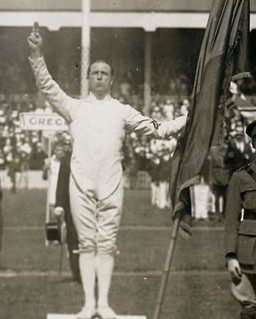
image
located by Jan Mertens, 20 September 2011
Almost the last photos on this page illustrate the first
Olympic oath, pronounced in Antwerp, 1920. Pronounced by fencer Victor Boin,
holding the Belgian flag in his right hand, the oath was delivered in front of
the stadium’s royal box as may be seen in the smaller photo.
Jan Mertens, 20 September 2011
I assisted to the AGM of the Belgian Olympic Committee.
Guest of honour was the Honorary president of the BOIC and the IOC, Jacques
Rogge. I had the chance to approach him and ask a simple question: does he know
where the Antwerp Flag is?
As you may recall, the Antwerp Flag was the official IOC
flag
(with rings and a fringe) that travelled from Antwerp via all the
Olympic cities to Seoul. In 1985 it was replaced by a new flag, made of Korean
silk, that has since travelled the world and is currently in Tokyo.
In all the articles about that change, it is mentioned that the Antwerp Flag
would be housed at the Olympic Museum in Lausanne. But it is not there.
So maybe Jacques Rogge knows where it is? Sadly he does not know either. "It is
a mystery", he said, which makes me conclude that the IOC does not know either,
and the flag is either still somewhere in a Seoul cellar, or it has been
destroyed.
That probably settles this question.
Herman, 04 June 2018
I had one specific reason reason to visit, which was that their City
Hall holds a 1920 Olympic Flag, described as being the first. The
personnel of the City Hall made a special quick visit possible, for
someone who would afterwards would have to cycle all the way North again. Let
me take the opportunity to add some comments. Feel free to quote me from
<>:
Five Rings to Bring Them All (Van-den-Muijzenberg, ICV 27).
A tale of Five Flags:
1 The very first flag of this design: This was the flags shown at the
Pan-Egyptian Games in Chatby Stadium, Alexandria, Egypt, in 1914,
announcing the festivities later that year in Paris. Thus it shows the
design before the letter.(Someone fill in the right expression, there.)
Eventually, this specimen ended up in Lausanne. This Alexandria flag /
Bolanaki flag is the first, but it was not yet an Olympic Flag as that
had yet to be determined.
2 Later in 1914, in Paris, supposedly the flag was adopted as the flag
of the Olympic Movement, but the outbreak of WWI stopped the
distribution of the decision about it. During the festivities nearly 500
flags were made and used for the festivities, and anecdotes have been
passed on about such specimen being taken back to the delegates home
country. We don't have actual evidence (please, feel free if you do),
though, so we can assume that likely some flags remained in Paris.
During the years, occasion flags were used at other occasions. Any flag
starting after the official part of the meeting would have been an
official Olympic Flag, should we manage to catch one or photograph of one.
3 In 1920, the Olympic Games were resumed, in Antwerp. They hoisted a
Stadium Flag. A large flag was hoisted and afterwards flown over the
entry arch. As such flags are higher, they have to be larger; in fact,
they have to be carried into the stadium by several flag bearers..
Unfortunately, this makes them more of a coveted object, and it was
stolen. The thieves were caught, I believe, but the flag was not
recovered. For Paris, 1924, a new Stadium Flag was made, but this again
was stolen. Parts of it were recovered, but not the entire flag. (If
anyone if provisioned in reading 1924 French police reports ...) It was
only in 1928 that they managed to keep their Stadium Flag. At
here, I very carefully built my
argument that what we see is Amsterdam's Marathon Tower. Unfortunately,
here, we see that same tower 8
years before its time under "Antwerp Olympic flag" as the background of
the Stadium Flag.
4 In 1920, Antwerp had been destroyed again, and they probably didn't
have the pecunia to go buy another set of 500 flags as festive
surroundings of the games. However, if someone in Paris had what was
left of nearly 500 flags from the 20-years jubilee, they could probably
have provided Antwerp with flags. These were ordinary flags, nothing
special about the, except that if you keep it in a suitcase for 80
years, it becomes an antique by existing that long. That was the kind of
flag Hal Haig Prieste stole at the end of the games, and which he
returned near the end of his life. Indeed, this is the flag that was
kept in the Antwerp City Hall, after he returned it to the IOC who
passed it to Lausanne, who passed it Antwerp as the original owners.
Thus, the existence of the Prieste flag has been documented from 1920
onward, and its origin is likely a 1914 flag. From personal observation,
I can add that it's a flag with very light green. In that way it is
different from the Bolanaki flag, and also from later flags, that all
have darker shades of green. (It would be interesting to know what other
specimen of this vintage still exist.)
5 In 1920, the Belgian Olympic Committee had to acknowledge, that they
could not have done all of that themselves. As such, at the closing
event, they presented the IOC with a large flag, with a six-coloured
border all around. This is the actual Antwerp Flag, being given to the
IOC in Antwerp. It's a large flag, but not so large that it can't be
carried by one person for a short distance, and it's border of the six
colours of the design make it unique among these flags. It was this flag
that was passed on to the start of the games to every new organiser.
Since Los Angeles / Seoul, a flag is now handed over at the end of the
games to the organisers to be. Note, that this was the end of the 1920
games; at the start of the games, the athlete held the Belgian flag.
Peter Hans van den Muijzenberg, 24 August 2023
I do remember when visiting
The Olympic Museum
in Lausanne that inside of the main halls on the first floor, one can see a very
old Olympic flag, displayed on a framed glass. Unfortunately no pictures were
allowed inside that exhibition, but I do recall that the flag was the standard
Olympic flag (rings on a white horizontal background) and below the rings a
golden embroided number, "1920".
At the moment I did not know if it was a variant of some sort, but now that I
read that it was the first Olympic flag (http://en.wikipedia.org/wiki/Olympic_flag#Flag
and
http://insider2012.blogspot.com/2012/01/celebrity-profile-hal-haig-prieste-1920.html
) then I come to realize that if the flag displayed at the Olympic Museum is not
the first truly Olympic flag, then it is one of many "original" flags that as
Herman de Wael mentions in his June 17, 2004 post.
Unfortunately the Museum is now closed for modifications, and surely a
renovation will take place (both in the website and in the museum) as they
mention on the official website: "After 20 years of existence, the institution
closes its doors on 29 January 2012 for renovations until the end of 2013". So
it would be difficult to locate the flag if someone would have the chance to
actually go there. I have tried submitting this topic to them, and let's see if
I can get a response.
Now, two links that may be proper to use as reference on their FAQ's:
- Q: Since when has the Olympic flag been raised at Olympic Games opening
ceremonies ?
A: In 1920 at the Games in Antwerp, the Olympic flag was raised for the first
time in an Olympic stadium. It was again Pierre de Coubertin who had the idea.
He presented it at the Olympic Congress in Paris in 1914, but the First World
War prevented the 1916 Games from being held in Berlin. As a result, it was the
city of Antwerp which saw the five-ring flag flying for the first time.
Source:
http://registration.olympic.org/en/faq/detail/id/146
- Q: Is it possible to obtain an Olympic flag?
A: The Olympic flag is to be used within the Olympic Games ceremonies only and
may therefore not be purchased. Olympic Charter: Chapter 1, Rule 7.2, p. 20
Source:
http://registration.olympic.org/en/faq/detail/id/24
Esteban Rivera, 23 April 2012
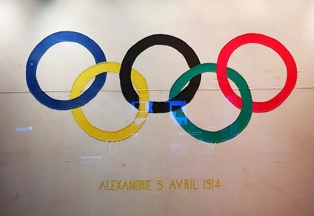
Turns out, there are some pictures available online of the actual flag, and they actually correspond to the flag I once spotted. In fact, the inscription I remembered is wrong. There is no "1920" date inscribed onto the flag as I first mentioned. Instead, the flag bears the five concentric Olympic rings and below an inscription in gold capitals that reads (in French): "ALEXANDRIE 5 AVRIL 1914" (English: "Alexandria, 5 April 1914").
